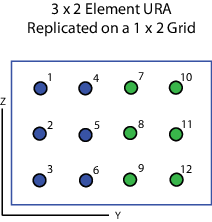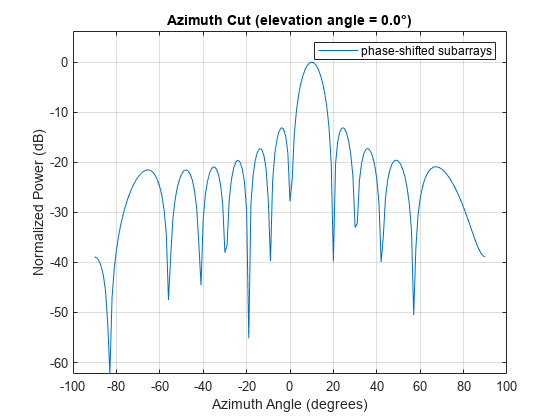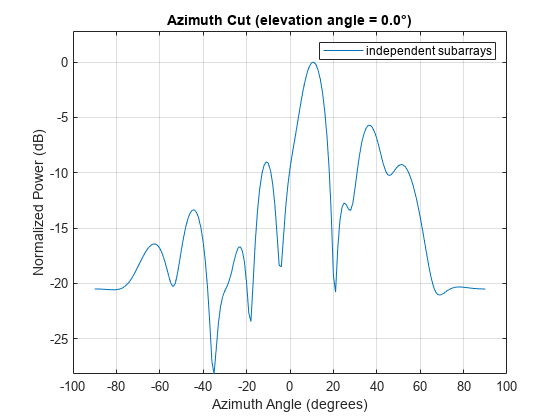phased.ReplicatedSubarray
Phased array formed by replicated subarrays
Description
The ReplicatedSubarray object represents a phased
array that contains copies of a subarray created by replicating a single specified
array.
To obtain the response of the subarrays:
Define and set up your phased array containing replicated subarrays. See Construction.
Call
stepto compute the response of the subarrays according to the properties ofphased.ReplicatedSubarray. The behavior ofstepis specific to each object in the toolbox.
You can also use a ReplicatedSubarray object as the
value of the SensorArray or Sensor property of
objects that perform beamforming, steering, and other operations.
Construction
H = phased.ReplicatedSubarray creates a replicated subarray
System object™, H. This object represents an array that contains
copies of a subarray.
H = phased.ReplicatedSubarray(
creates a replicated subarray object, Name,Value)H, with each specified property
Name set to the specified Value. You can specify additional name-value pair arguments in
any order as
(Name1,Value1,...,NameN,ValueN).
Properties
| Subarray to replicate Specify an array type to use to replicate as subarrays. The array types that you can use are:
You cannot use the Default: |
| Layout of subarrays Specify the layout of the replicated subarrays as
Default: |
| Size of rectangular grid Specify the size of the rectangular grid as a single positive integer or
1-by-2 positive integer row vector. This property applies only when you set
the If If
Default: |
| Spacing of rectangular grid Specify the rectangular grid spacing of subarrays as a positive
real-valued scalar, a 1-by-2 row vector, or If If If Default: |
| Subarray positions in custom grid Specify the positions of the subarrays in the custom grid. This property value is a 3-by-N matrix, where N indicates the number of subarrays in the array. Each column of the matrix represents the position of a single subarray in the array’s local coordinate system, in meters, using the form [x; y; z]. This property applies when you set the Default: |
| Subarray normal directions in custom grid Specify the normal directions of the subarrays in the array. This property value is a 2-by-N matrix, where N is the number of subarrays in the array. Each column of the matrix specifies the normal direction of the corresponding subarray, in the form [azimuth; elevation]. Each angle is in degrees and is defined in the local coordinate system. You can use the This property applies when you set the Default: |
| Subarray steering method Specify the method of subarray steering as either
Default: |
| Subarray phase shifter frequency Specify the operating frequency of phase shifters that perform subarray
steering. The property value is a positive scalar in hertz. This property
applies when you set the Default: |
| Default: |
Methods
Specific to
phased.ReplicatedSubarray Object | |
|---|---|
beamwidth | Compute and display beamwidth for a subarray |
collectPlaneWave | Simulate received plane waves |
directivity | Directivity of replicated subarray |
getElementPosition | Positions of array elements |
getNumElements | Number of elements in array |
getNumSubarrays | Number of subarrays in array |
getSubarrayPosition | Positions of subarrays in array |
isPolarizationCapable | Polarization capability |
pattern | Plot replicated subarray directivity and patterns |
patternAzimuth | Plot replicated subarray directivity or pattern versus azimuth |
patternElevation | Plot replicated subarray directivity or pattern versus elevation |
sidelobelevel | Peak and integrated sidelobe levels |
step | Output responses of subarrays |
phased.ReplicatedSubarray.viewArray | View array geometry |
| Common to All System Objects | |
|---|---|
release | Allow System object property value changes |
Examples
References
[1] Mailloux, Robert J. Electronically Scanned Arrays. San Rafael, CA: Morgan & Claypool Publishers, 2007.
[2] Mailloux, Robert J. Phased Array Antenna Handbook, 2nd Ed. Norwood, MA: Artech House, 2005.
Extended Capabilities
Version History
Introduced in R2012a



